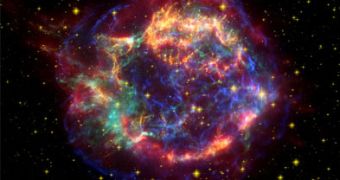Cassiopeia A is a supernova remnant located about 9,000 light years away from Earth which was created by a supernova explosion somewhere around the year 1680 and one of the brightest radio sources in the sky. Although modern observations taught much about the expanding remnant, one particular problem remained to be solved - what kind of supernova created the Cassiopeia A remnant.
Light echoes originating from the explosion that took place more than three centuries ago now reveal that Cassiopeia A was formed by a Type IIb supernova remnant, which occurs when a red giant star consumes the nuclear fuel in the outer layers and the core collapses on itself.
"We are able to conclude what type of supernova it was, which is certainly the most important result scientifically. It brings together the wealth of observation about the remnant with the explosion", said Oliver Krause from the Max Planck Institute for Astronomy.
In the last two millennia only six supernova explosions occurring in the Milky Way galaxy were observed from Earth, out of which just one was observed with modern equipment, leaving astronomers with very little information to work with while investigating such events. However, light echoes are now helping compensate for the lack of observations.
Supernova explosions take place when the progenitor star depletes its nuclear fuel and is no longer able to balance the nuclear and gravitational forces acting on it. As a result, the outer layers of the star are blown outwards, at the same time determining electromagnetic radiation emissions so powerful that some can even outshine an entire galaxy.
Some of that light eventually reaches Earth, but the speed of light is limited, meaning that if an explosion took place five centuries ago there is a good chance that an interstellar cloud of dust located about 250 light years from the supernova will reflect part of the light it receives in our direction, to create a light echo.
So Krause's team went looking for the electromagnetic signature of the Cassiopeia A remnant. They found something in images taken by the Spitzer Space Telescope during the testing stage in 2003 and proved that the infrared spectrum of light was determined by a Type IIb supernova.
"The signature of the supernova flash illuminated this dust cloud. The light is reflected back, and by analyzing this echo you can study the original light outburst. Like with a time machine, we see the 300-year-delayed echo", Krause said.
"This is an important paper about a very important object. What type of supernova caused Cass A has been an enduring mystery for astronomers since it was detected in radio, and Krause's team has acquired the key piece of information that allows us to understand it", said professor Doug Welch from the McMaster University.

 14 DAY TRIAL //
14 DAY TRIAL //